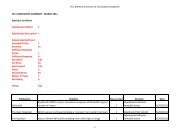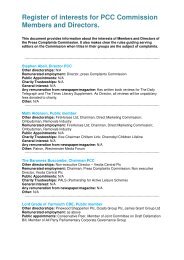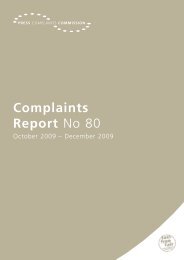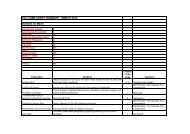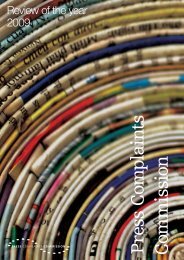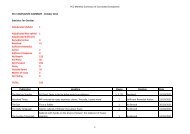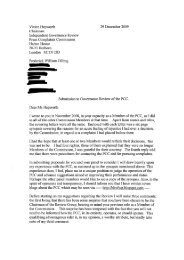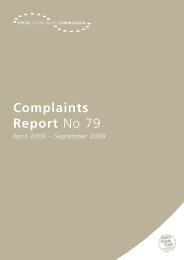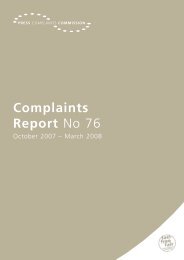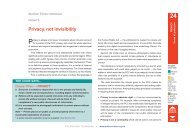2008 - Press Complaints Commission
2008 - Press Complaints Commission
2008 - Press Complaints Commission
Create successful ePaper yourself
Turn your PDF publications into a flip-book with our unique Google optimized e-Paper software.
SPECIAL REPORT –<br />
PRIVACY<br />
Trials can be a counter-productive way of settling<br />
disputes about an alleged privacy intrusion. The<br />
adversarial and formal nature of a trial, coupled with the<br />
human interest in such cases, means they attract a huge<br />
amount of media attention. And yet a trial held in camera<br />
would run contrary to the principle of open justice.<br />
What’s more, the PCC has heard from people<br />
who regret seeking an injunction because any further<br />
inquiries into matters that might touch on the subject<br />
of the injunction have to be referred to lawyers. This of<br />
course has serious ongoing cost implications.<br />
There is also the question of inaccessibility; in<br />
<strong>2008</strong> we received complaints from people who had<br />
found the law a slow and tortuous process – our service<br />
on the other hand is flexible, quick and free of charge.<br />
PRIVACY AND<br />
HARASSMENT<br />
Images of people being chased by photographers<br />
are seen as an example of the worst sort of press<br />
behaviour. But, as with much of the PCC's work, there<br />
is a balance to be struck in terms of what is acceptable –<br />
for there are competing interests at stake. Some<br />
photographers can overstep the mark and individuals can<br />
feel threatened, but it’s important to bear in mind that:<br />
• As part of freedom of expression in an open society,<br />
the public has a right to see images of people who<br />
are in the news, whether they have a fleeting brush<br />
with fame or deliberately seek publicity;<br />
• There’s no legal restriction on individuals taking<br />
pictures in public places and moves to create one<br />
would affect every person in the UK with a camera,<br />
not just the paparazzi;<br />
• Photographers are not a homogenous industry<br />
and standards of behaviour differ. It would be<br />
counterproductive for established agencies to have<br />
a reputation for harassing people, as editors would<br />
cease buying their images. But from the evidence<br />
we see, it seems apparent that there are a number<br />
of unscrupulous individuals whose behaviour lowers<br />
the reputation of all professional photographers;<br />
• Photography is not a regulated profession.<br />
That said, individuals in the news have equally<br />
important rights not to be harassed unless there is<br />
some public interest for pursuing them. The relevance<br />
of the PCC is that – regardless of who has taken<br />
a photograph, be it a staff photographer, agency,<br />
individual paparazzo or member of the public – editors<br />
must take care not to publish one that has been taken<br />
as a result of harassment. This may be easier said<br />
than done – so to assist editors in making the correct<br />
decisions, and to minimise the intrusion to the<br />
individual, the PCC has a system of ‘private advisory<br />
notes’ (also known as ‘desist messages’) that are<br />
circulated to senior editorial figures and newspaper<br />
lawyers across the country, and which highlight<br />
problems while they are going on so that immediate<br />
steps can be taken to resolve the matter. The system<br />
works in the following way:<br />
• Someone approaches the PCC because they have<br />
experienced unwanted attention from journalists<br />
or photographers, or fear they may be about to;<br />
• We discuss their circumstances and ask a number<br />
of questions, including whether they are intending to<br />
do - or already have done - a deal with other media;<br />
• If they have a case of potential harassment,<br />
we send an e-mail requesting that journalists<br />
or photographers cease their approaches;<br />
• This also alerts editors to the danger of publishing<br />
a picture from a freelancer, as they are responsible<br />
for the manner in which a picture is taken;<br />
• We never instruct editors what they can and cannot<br />
publish – we simply arm them with extra information to<br />
make their own decisions under the Code of Practice.<br />
The effect is generally that the harassment<br />
stops or that the photographs concerned do not get<br />
published. This in turn acts as a disincentive for<br />
freelance paparazzi to continue pursuing the individual.<br />
From the editors’ point of view, they also minimise<br />
the chance of a formal PCC complaint of harassment<br />
after the event, or the risk of legal action.<br />
One high profile individual who used the service<br />
in <strong>2008</strong>, when her personal circumstances changed, was<br />
the television newsreader Natasha Kaplinsky. She said:<br />
“When I had my baby last year, I didn’t want to<br />
be followed around by photographers every time<br />
I left the house, as happened when I was pregnant.<br />
We asked the PCC to issue a private request<br />
to photographers to stop following us, and to<br />
newspapers and magazines not to use pictures of<br />
me taken when I was with my family in private time.<br />
The degree of compliance was very impressive, and<br />
I would recommend this service to anyone in a similar<br />
position.” But this system is chiefly used by ordinary<br />
members of the public, as set out below.<br />
PREVENTATIVE<br />
WORK – FREE,<br />
CONFIDENTIAL<br />
AND COLLABORATIVE<br />
Discussions about pre-publication privacy issues<br />
have often focused on injunctions by the courts.<br />
However, the process can be expensive when<br />
challenged by the media, appealed and overturned.<br />
What’s more, the resultant story can appear rather<br />
more prominent than originally intended.<br />
The PCC has a 24-hour emergency service<br />
through which pre-publication issues can be raised<br />
and resolved. Whilst we have no formal powers of prior<br />
restraint, if a complainant contacts us with legitimate<br />
concerns, we quickly work with both parties to try to sort<br />
out the issue. These discussions affect the way in which<br />
the newspaper handles publication of the story and may<br />
lead to it not appearing at all.<br />
LEFT: TV<br />
Newsreader<br />
Natasha<br />
Kaplinsky,<br />
FIVE <strong>2008</strong><br />
Examples in <strong>2008</strong> where our discussions<br />
prevented stories from being published include:<br />
• A soap star was contacted about her pregnancy.<br />
Although she had informed some of her family,<br />
friends and colleagues, she did not want it to be<br />
made public. We referred to past decisions by the<br />
PCC which had ruled that the existence of pregnancy<br />
in the first twelve weeks was private;<br />
• A rumour was circulating that a celebrity had entered<br />
rehab. Their representative contacted us saying that it<br />
was a private matter relating to that person’s health;<br />
• Two teachers, who were in a relationship, discovered<br />
that their local paper had been sent personal<br />
information by a former partner who was seeking to<br />
embarrass them. We pointed out that, if the paper used<br />
this material, it would be assisting in that harassment;<br />
• A national newspaper intended to publish a story about<br />
a practising dentist who was infected with HIV and<br />
Hepatitis C. The individual made clear that he was<br />
following established protocol as to how such a situation<br />
should be handled and that there was no public interest<br />
in the wider dissemination of details of his illness.<br />
Far from stifling freedom<br />
of expression, this system<br />
preserves it, ensuring<br />
that newspapers take<br />
informed decisions about<br />
what to publish<br />
This PCC service is used both by those in the<br />
public eye and ordinary citizens caught up in a news<br />
story. It’s free and confidential, requires no legal<br />
representation and doesn’t generally lead to<br />
subsequent challenge and argument. What’s more,<br />
people who are concerned about the accuracy of an<br />
article can ensure that any points are made before<br />
publication so that there is no need for a complaint<br />
afterwards. For example:<br />
• Two MPs were concerned that inaccurate information<br />
about their housing expenses might be published.<br />
Through the PCC, they made clear the correct<br />
position, which newspapers were able then to use;<br />
• A woman was worried that a national newspaper<br />
was intending to publish allegations of benefit<br />
fraud. She used the PCC to provide off-the-record<br />
information, which influenced its decision over<br />
whether to run the story;<br />
• A political figure was concerned about allegations<br />
relating to his behaviour before taking a new role.<br />
Having highlighted inaccuracies in the proposed<br />
story, the paper published an article but it did not<br />
include some of the claims he had denied.<br />
Far from stifling freedom of expression, this<br />
system preserves it, ensuring that newspapers take<br />
informed decisions about what to publish.<br />
OUR INTERVENTION<br />
IN CASES OF<br />
HARASSMENT<br />
In our busiest year yet, the following are just a few of<br />
the people we helped:<br />
• The actress Sienna Miller was being continually harassed<br />
by photographers. The PCC sent out messages on her<br />
behalf on two occasions and also handled specific<br />
concerns about one national newspaper;<br />
• A television presenter was receiving persistent<br />
attention from photographers outside her home.<br />
She wanted newspapers to be aware of the fact<br />
that she had been pursued (sometimes dangerously)<br />
by paparazzi in cars;<br />
• A woman who lost her husband when she was<br />
pregnant didn’t want to be harassed at her home,<br />
especially with her new baby. The PCC communicated<br />
this across the industry and no photographs were<br />
subsequently published;<br />
• A representative of a couple whose son died on a scout<br />
trip contacted the PCC to express concern that they<br />
were the recipient of numerous calls from journalists<br />
requesting (and offering payment for) interviews;<br />
• The daughter of an 82-year-old lady who was visited by<br />
a reporter from a national newspaper – in connection<br />
with a financial scandal involving her grandson –<br />
requested that she not be contacted again;<br />
• The family of a four-year-old girl who died in hospital<br />
contacted the PCC through Merseyside Police<br />
requesting that they not be approached for comment<br />
and for journalists not to attend the funeral.<br />
8 9




